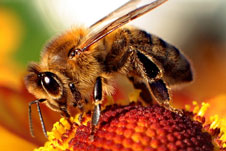 Wednesday 2 March 2016 11:46am
Wednesday 2 March 2016 11:46am
Honeybees suffer severe learning and memory deficits after ingesting very small doses of the pesticide chlorpyrifos, potentially threatening their success and survival, new University of Otago research suggests.
In their study, researchers from the Departments of Zoology and Chemistry collected bees from 51 hives across 17 locations in the province of Otago in Southern New Zealand and measured their chlorpyrifos levels. They detected low levels of pesticide in bees at three of the 17 sites and in six of the 51 hives they examined.
Detecting chlorpyrifos was not a surprise. In 2013, Associate Professor Kim Hageman and her team from Otago's Department of Chemistry showed that chlorpyrifos was detectable in air, water, and plant samples even in non-sprayed areas of the country, because this pesticide has a high ability to volatilise and travel great distances.
In the laboratory they then fed other bees with similar amounts of the pesticide, which is used around the world to protect food crops against insects and mites, and put them through learning performance tests.
Study lead author Dr Elodie Urlacher says they found that chlorpyrifos-fed bees had worse odour-learning abilities and also recalled odours more poorly later, even though the dose they ingested is considered to be "safe".
“For example, the dosed bees were less likely to respond specifically to an odour that was previously rewarded. As honeybees rely on such memory mechanisms to target flowers, chlorpyrifos exposure may be stunting their effectiveness as nectar foragers and pollinators,” Dr Urlacher says.
The study identified the threshold dose for sub-lethal effects of chlorpyrifos on odour-learning and recall as 50 picograms of chlorpyrifos ingested per bee, she says.
“This amount is thousands of times lower than the lethal dose of pure chlorpyrifos, which is around 100 billionths of a gram. Also, it is in the low range of the levels we measured in bees in the field.”
The current study is the first to establish the threshold at which a pesticide has an effect on memory specificity in bees while also measuring doses in bee populations in the field, she says.
“Our findings raise some challenging questions about regulating this pesticide's use. It's now clear that it is not just the lethal effects on bees that need to be taken into account, but also the serious sub-lethal ones at minute doses,” Dr Urlacher says.
The research, which appears in the Journal of Chemical Ecology, was supported by the Marsden Fund of New Zealand.
For more information, contact:
Dr Elodie Urlacher
Department of Zoology
University of Otago
Tel 64 3 479 4039
Email elodie.urlacher@otago.ac.nz
Publication details:
Measurements of Chlorpyrifos Levels in Forager Bees and Comparison with Levels that Disrupt Honey Bee Odor-Mediated Learning under Laboratory Conditions
Elodie Urlacher, Coline Monchanin, Coraline Rivière, Freddie-Jeanne Richard, Christie Lombardi, Sue Michelsen-Heath, Kimberly J. Hageman, Alison R. Mercer
DOI: 10.1007/s10886-016-0672-4
A list of Otago experts available for media comment is available elsewhere on this website.
Electronic addresses (including email accounts, instant messaging services, or telephone accounts) published on this page are for the sole purpose of contact with the individuals concerned, in their capacity as officers, employees or students of the University of Otago, or their respective organisation. Publication of any such electronic address is not to be taken as consent to receive unsolicited commercial electronic messages by the address holder.